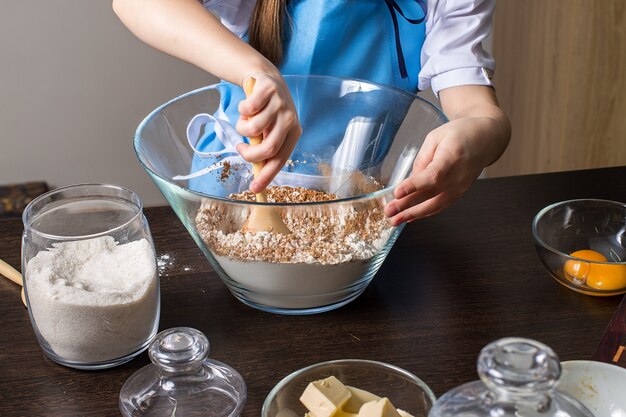Converting Grams to Cups: Mastering the Art of Ingredient Measurement
In the world of cooking and baking, precision can make the difference between a culinary masterpiece and a kitchen disaster. Many recipes originate from all around the world, leading to the frequent requirement to switch between metric measurements like grams and cups. Particularly, home cooks and bakers find themselves scratching their heads over the challenge of converting grams to cups. But worry not—this guide is here to provide all the information you need, simplifying the seemingly daunting task. Let's dive in and explore how to transfer grams to cups with ease and accuracy.
Navigating Weight and Volume in the Kitchen
Understanding the Basics
Before delving into conversions, it's vital to grasp the difference between weight and volume-based measurements.
- Grams: A metric unit measuring weight. It's precise and commonly used in scientific and global culinary contexts.
- Cups: A volume measurement more common in American recipes. It measures the space an ingredient occupies rather than its weight.
Why Conversions Matter
Different recipes call for different units, and knowing how to convert them is crucial to maintain the recipe's integrity. Whether you're following an international recipe or adjusting portion sizes, converting grams to cups correctly ensures your dish meets expectations every time.
The Conversion Challenge
The Influence of Ingredient Density
Different ingredients have different densities, meaning one cup of flour will weigh differently than one cup of sugar. This density affects the conversion rate between grams and cups. Here are some examples:
- Flour: Generally, one cup of all-purpose flour weighs approximately 125 grams.
- Sugar: One cup of white sugar weighs around 200 grams.
- Butter: One cup of butter weighs around 227 grams.
These variations illustrate why a straightforward conversion of grams to cups isn't always feasible without considering the ingredient's density.
General Conversion Tips
It's beneficial to equip your kitchen with a food scale and measuring cups. For precise baking and cooking, weighing your ingredients in grams with a scale and converting only when necessary is often the best practice.
Ingredients and Their Conversion Ratios
Flour: A Baking Staple
- All-Purpose Flour: Approximately 125 grams per cup.
- Whole Wheat Flour: Slightly denser, roughly 130 grams per cup.
Sugars: Sweet and Varied
- Granulated Sugar: 200 grams per cup.
- Brown Sugar: Tightly packed, measuring around 220 grams per cup.
Liquids: Pouring into Conversions
For liquids, the conversion process tends to be simpler. A standard cup is 240 milliliters or approximately 240 grams of water.
Other Common Ingredients
- Rice: 195 grams per cup.
- Rolled Oats: About 90 grams per cup.
A Handy Conversion Table
| Ingredient | Grams per Cup |
|---|---|
| All-Purpose Flour | 125 |
| Granulated Sugar | 200 |
| Brown Sugar | 220 |
| Butter | 227 |
| Rice | 195 |
| Water | 240 |
Practical Conversion Methods
Using Online Conversion Tools
Several online calculators and conversion tools can ease the burden of manual calculations. These tools can get you started, but understanding the principal concepts empowers you to adapt to any situation without a calculator.
Conversion Formula
To convert grams to cups manually, use the formula:
[ ext{Cups} = frac{ ext{Grams}}{ ext{Grams per Cup}} ]
For example, to convert 250 grams of flour to cups:
[ ext{Cups} = frac{250 , ext{grams}}{125 , ext{grams per cup}} = 2 , ext{cups} ]
🧁 Quick Reference Tips
- Always level your measuring cup for solid ingredients to avoid rounding errors.
- Use scales for maximum precision, especially for baking.
- Keep a conversion chart handy in your kitchen for quick checks.
Tackling Common Questions and Errors
Should You Pack or Scoop?
Understanding whether to pack an ingredient, such as brown sugar, or to scoop it lightly can impact the measurement significantly. Always follow recipe-specific instructions.
Dealing with Unique Ingredients
For items not commonly listed, such as specialty flours, research or use a scale to determine the specific conversion rate, consulting ingredient-specific tables whenever possible.
🌟 Essential Takeaways
- Measurements Matter: Accurate conversions maintain recipe integrity.
- Tools Are Your Friend: Utilizing a scale and measuring tools can save time and hassle.
- Practice Makes Perfect: Familiarity with conversion ratios and tools enhances cooking and baking outcomes.
Empowering Your Cooking Creativity
Transferring grams to cups can initially seem complex, but with practice and the right tools, it becomes a seamless part of your routine. This knowledge opens doors to a world of diverse recipes, empowering you to experiment and indulge in global cuisines with confidence. Whether you're crafting a French patisserie dessert or a hearty Italian pasta dish, mastering measurement conversions is key to culinary success.
With this comprehensive guide, you're equipped with the understanding and skills to convert grams to cups for a variety of ingredients, helping you maintain precision and integrity in your kitchen adventures. Happy cooking! 🍳🥣

Related Topics
- How Can I Transfer Data From One Laptop To Another
- How Can I Transfer Domain To Godaddy
- How Can I Transfer My Calls To Another Phone
- How Can I Transfer Pdf To Word
- How Can We Transfer Data From One Laptop To Another
- How Can You Transfer Data From One Phone To Another
- How Can You Transfer Emails From One Account To Another
- How Can You Transfer Vhs Tapes To Dvd
- How Do I Transfer a Prescription From Walgreens To Cvs
- How Do I Transfer Data From Ipad To Ipad